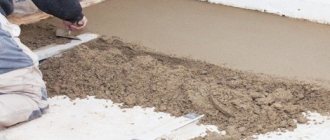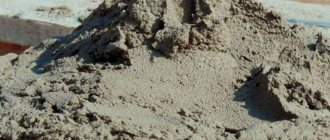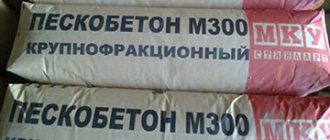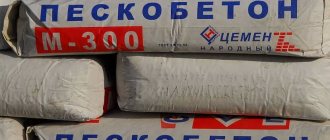Home » Optimal consumption of sand concrete will save money on construction sites
Important!
Please note that the articles on the site are for informational purposes only.
We do not provide technology consultations. In construction practice, there is a material that will allow you to make a screed without purchasing separately sand and cement, which cause many inconveniences when placed on site. The sand concrete is already ready for use and all that remains is to add water to it.
AVERAGE MIXTURE CONSUMPTION PER 1M2
There is a simplified formula that will help you find out the consumption of sand concrete per 1 m2.
The material consumption is calculated from the condition that for a layer 1 cm thick with an area of 1 m2, an average of 18 to 20 kg of mixture will be needed. Flow data can be applied to different layer thicknesses. In this case, you just need to find out the number of centimeters and multiply the number by kilograms.
Sand concrete M-300 40kg
Sand concrete M-300 is a non-shrinking mixture for constructing high-strength wear-resistant floors as a load-bearing layer in basements, garages, workshops, as well as during installation work. Sand concrete M-300 is also widely used as fine-grained concrete for foundations, castings, etc. They are used in interior and exterior work. Surface preparation: The working surface must be dry, hard (durable), free of paint. Oil, dust, soot and loose elements must be removed. Clean or wash off non-waterproof coatings. The base must be moistened with water in advance. Directions for use: Mix thoroughly until a homogeneous, elastic consistency is obtained manually or mechanically. The consistency of the mortar mixture should be between the stable and plastic categories. Too dry a consistency will degrade the quality of the surface. Too wet - reduces strength and leads to cracks. It is recommended to compact the material thoroughly and evenly. Drying time at base and air temperatures from +5 to +25 C is achieved within 24 hours Consumption - 20 kg/sq.m. with a thickness of 10 mm. Solution - 4 - 4.5 l./25 kg. ..
90.00 rub.
Sand concrete Luix/Luix M300 40kg
Sand concrete m300 is used at all stages of construction: from foundation construction to finishing work. It is also widely used for strengthening or repairing and restoring old reinforced concrete elements, as it has high adhesion. Due to the excellent resistance of M300 sand concrete to the external environment, humidity and low temperatures, it is used in both interior and exterior decoration during construction. Another advantage of M300 sand concrete is the possibility of urgent concreting (the surface becomes hard after 48 hours) in conditions of high humidity and a temperature of at least +5°C. Preparation of the base: The surface on which M300 sand concrete will be laid requires preliminary preparation. It should be cleaned of dust and slightly moistened. Preparation of the mixture: To obtain a solution ready for use, M300 sand concrete is poured into a mixing container or concrete mixer, water is added and stirred until smooth in proportions: for ten kilograms of dry mixture you need one and a half to two liters of water. To obtain one cubic meter of screed or foundation, 1.6 tons of solution is required. ..
135.00 rub.
Sand concrete Mansurovskoe quarry management M300 coarse-grained 40 kg
..
110.00 rub.
Sand concrete M-300 FinStroy 40kg
Sand concrete m300 is used at all stages of construction: from foundation construction to finishing work. It is also widely used for strengthening or repairing and restoring old reinforced concrete elements, as it has high adhesion. Due to the excellent resistance of M300 sand concrete to the external environment, humidity and low temperatures, it is used in both interior and exterior decoration during construction. Another advantage of M300 sand concrete is the possibility of urgent concreting (the surface becomes hard after 48 hours) in conditions of high humidity and a temperature of at least +5°C. Preparation of the base: The surface on which M300 sand concrete will be laid requires preliminary preparation. It should be cleaned of dust and slightly moistened. Preparation of the mixture: To obtain a solution ready for use, M300 sand concrete is poured into a mixing container or concrete mixer, water is added and stirred until smooth in proportions: for ten kilograms of dry mixture you need one and a half to two liters of water. To obtain one cubic meter of screed or foundation, 1.6 tons of solution is required. ..
150.00 rub.
Sand concrete M300 Stone flower 40kg
Dry construction mixture M300 sand concrete “Stone Flower” contains cement grades PTs 400D0, PTs 500D0 and fractional sand and is a non-shrinking mixture used to create high-strength concrete pavements. In particular, “Stone Flower” sand concrete is used for building foundations, pouring concrete coverings in garages, basements, industrial premises, sealing concrete walls, concreting stairs, screeding floors and other tasks. ..
185.00 rub.
Sand concrete M300 Rusean 40kg
This mixture is used for the construction of high-strength wear-resistant floors as a load-bearing layer in basements, garages, workshops, production shops, as well as during installation work. Widely used as fine-grained concrete for foundations and castings. Substrate preparation: The surface to be treated must be durable and free of paint. Oil, dust and flaking elements must be removed, and non-waterproof coatings must be washed off. Do not apply to plaster base. Preparation of the mixture: Add 7.5 liters of water to the contents of the bag (50 kg); Mix thoroughly until a homogeneous mass is obtained (mixing should be done mechanically or manually) Recommendations: Lack of water in the solution worsens the quality of the surface, excess water leads to a decrease in strength and the formation of cracks. When working with the solution, carefully compact the material. Joints or surfaces adjacent to each other should be connected with metal reinforcement. To improve adhesion to the base, the surface of the base should be treated with Betokontakt primer. Consumption: Consumption of sand concrete up to 22 kg per 1 sq. m with a layer thickness of 10 mm. Technical characteristics: Use the resulting solution within 1.5-2 hours; The time for complete hardening at base and air temperatures from +5°C to +25°C is 24 hours; Water consumption – 0.15 l/kg Mobility – Pk3 Compressive strength – 30 MPa ..
148.00 rub. 150.00 rub. %
Buy sand concrete
Preparing the mixture
The intermediate layer should be no more than 3 cm thick; it is better to use expanded clay. For screed construction, the material consumption will be 1:2 (expanded clay and sand concrete). Expanded clay granules will ensure the light weight of the solution, such installation will be economical and at the same time the strength properties will not be reduced. When pouring the screed, reinforcement should be laid. This procedure will prevent cracks from occurring after the solution dries.
When the consumption rate of sand concrete is known, the next step is to make the correct batch. It is recommended to perform the work in the following sequence:
- a container of the required size is filled with warm water, approximately from +15 to +25 degrees. For one kg of sand concrete, water consumption is 180-230 ml;
- Dry composition is added to the water;
- The mixture should be thoroughly mixed until even the slightest clots disappear. As a result, the solution should be homogeneous.
Water cannot be added to the prepared solution. When pouring, the mixture should be pierced from time to time. To do this, you can use a stake, rod or shovel to eliminate air bubbles.
This sand concrete mixture must be used within two hours. Performs work with M300 brand solution, recommended at temperatures from +5 to +35 degrees. It will take a day to dry completely, and you can only walk on the screed after 7 days. The formwork is dismantled on the second day. Sand concrete structures will acquire full strength characteristics in 28 days, just like conventional concrete structures.
It is necessary to reinforce the screed if it reaches a thickness of more than 2 cm. It is recommended to install the frame when pouring the foundation. There is no need to add crushed stone to the mixture; it will be replaced by sand with a coarse fraction of 3-7 millimeters. It is recommended to carry out waterproofing as usual.
HOW MUCH IS ONE BAG OF MIXTURE ENOUGH?
To find out the consumption of a bag of sand concrete per unit area, you need to determine how many kilograms it contains. The packaging is mainly carried out in bags weighing 50 and 40 kg. It means:
- With a bag weight of 40 kg and a middle layer of 1 cm, it is enough for 2 m2 (40/20 = 2). The consumption is 20 kg. To obtain the flow rate per m3, you need 40/2000 = 0.02 m3.
- With a bag weighing 50 kg, it turns out that it is enough for 2.5 m2 (50/20 = 2.5). The layer thickness is 1 cm. Consumption is 20 kg. To get the flow rate per m3, you need 50/2000=0.025 m3.
When preparing the solution, you will need water, which by volume should be approximately 30% of the dry mixture. Here you need to add it not immediately, but gradually until you get a plastic mass and too liquid.
Consumption rates for sand concrete depend on the type of material. The amount of water in the finished mixture is also of great importance.
For each type of mixture, the manufacturer writes on the packaging the average consumption, as well as how much water is needed for 1 bag. If there are a lot of indentations on the base, then they will also increase the overall consumption.
Consumption per 1 square meter
The sand concrete consumption calculator is used using the formula for 1 m2. As a result, you will get cost data for premises; you only need to know the parameters of the intermediate surface and the amount of dry mortar. If the layer is 1 cm, you need about 18 kg. When they take data on the consumption of building materials of 50 kg per sq. m. m., the result will be such that 1 bag is not enough to process three m2.
High-quality sand concrete is produced only at enterprises with expensive mixing and dosing equipment. The building material undergoes various inspections and tests in laboratory conditions.
The calculation of the quantity will be given using the example of an apartment of 100 sq.m. and will look like this:
- The layer thickness is 5 cm.
- The required volume is obtained by multiplication - 18 kg x 100 m2 x 5.
- Since the building material is packaged in 50 kg packs, the result is 180 bags (9 tons).
The amount of solution depends on the brand and properties of the surface layer on which the work will be done. When leveling a floor surface, the above formula will not give accurate results, because the uneven surface is not the same everywhere. If you do not take into account the unevenness of the floor, then the calculation is simple. The thickness of the screed usually does not exceed 7 cm. For one meter 2 you will need:
- 70 mm divided by 15 mm multiplied by 18 kg, the result is 84 kg of dry composition.
The screed is needed to smooth out protrusions and differences on the floor surface. Accordingly, you need to calculate what the thickness of the screed will be. If the protruding element is not possible to somehow smooth out. It is recommended to take the highest point and use it as a guide when determining the required thickness and amount of building material.
Sand concrete compositions are used mainly for pouring screeds in industrial and residential premises. Before pouring, you need to determine how much building materials you will need to purchase. Such dry mixtures are presented in bags weighing 40 and 50 kg. The consumption of sand concrete m300 per 1 m2 with a thickness of 10 mm will be 20 kg. A screed of 2 cm will require 40 kg. When the area of the room is known, calculating the required amount will be quite easy. For example, a building of 200 m2 requires 200 units. packages of sand concrete mixture.
How to determine the amount of building mixture for different types of work? It is known that there will not be any particular difficulties in calculating the thickness of the plaster and the area of the room. But for brick partitions you will need to take into account the filling of the seams.
HOW MUCH SAND CONCRETE IS NEEDED FOR DIFFERENT TYPES OF USE?
When using sand concrete to create a screed, you can calculate in advance how much dry mixture will be needed. As a rule, the screed is made at least 2 cm thick. Therefore, if you need to fill 10 m2 with a 5 cm thick screed and you need to find out how many 50 or 40 kg bags are needed, we get:
- 20x5x10=1000 kg of dry mixture. If the bags weigh 50 kg, then 1000/50 = 20 bags. With a weight of 40 kg 1000/40 = 25 bags.
If sand concrete is used as plaster, then the calculation will be the same. However, in most cases the layer is no more than 1 cm.
Therefore, the calculation for 10 m2 of plaster and a layer thickness of 0.5 cm will be as follows: 20x0.5x10 = 100 kg of dry mixture. If the bags are 50 kg, then 100/50 = 2 bags. With a weight of 40 kg 100/40 = 2.5 bags.
Why do you need a preliminary calculation?
Before proceeding with the installation of cement screed and plaster, it is necessary to accurately determine the amount of M300 sand concrete. An incorrect calculation will lead to an unjustified interruption during the installation process due to a lack of material.
This will lead to additional costs associated with the transition of workers to other types of work, delay of subcontractors, who may impose penalties. It may happen that there will be excess material, which will then be difficult to sell.
In order to accurately determine the need for dry mixture for a certain amount of work, it is necessary to prepare the room for the installation of screed and plaster. To do this, you need to level the base under the screed, seal holes, potholes, deep cracks with ordinary cement mortar. Install formwork and sleeves in places where future communications will pass, and mount beacons. Such preparation will allow you to more accurately calculate the material requirements for the entire scope of work.
Manual semi-dry sand concrete screed
If you plan to prepare M300 sand concrete yourself to fill the floor, then you need to know the correct proportions. The basis of sand concrete is Portland cement (grades from M300 to M500 in this case), sand of different fractions (accounts for two-thirds of the volume). For floor screed, the following mixture is suitable: 1 part Portland cement M300 and 2-3 parts coarse river sand. The plasticizer is added at the rate of 2% of the total volume of the solution.
To get one ton of sand concrete, about 220-240 kilograms of Portland cement and 800 kilograms of filler (sand and crumbs or only sand) are mixed. This recipe is considered optimal, but the surest option is to purchase a ready-made dry mixture of M300 sand concrete, which can be easily found in Moscow and the regions.
Composition and main characteristics of sand concrete
In fact, this is an ordinary dry batch of three main components, well dried and free of foreign matter:
- The fourth part of the mixture is the binding material - Portland cement grade 500;
- Plasticizing additives and fiber fiber;
- Three quarters - sand of fractions 0.5-0.8 mm, for screeds, gravel screenings of 2-4 mm, clay can be additionally added;
Sand concrete M300, intended for making concrete screeds and pouring floors, is characterized by the presence of large fractions of gravel, sand and grains, so the manufacturer usually labels the mixture or indicates its purpose on the packaging.
For example, the Leroy Merlin company simply writes the name on the packaging - floor screed, accordingly, the buyer himself must guess that the composition of such sand concrete contains small fractions of gravel, and it is not suitable for plaster. More serious manufacturers assign special indices to the M300 brand. For example, sand concrete M300 mku. The standard for structure and composition is initially aimed at repairing and pouring concrete floors.
Sand concrete M300, after a set of calculated strength characteristics, is capable of withstanding compressive contact pressure of up to 300 kg/cm2. The density of sand concrete m300 ranges from 1800 to 2200 kg/m3. In fact, this is enough to use dry sand concrete mixture to prepare a batch for pouring the foundation and most structural elements of low-rise construction.
For your information! For 1 m3 of a foundation made of lightweight M300 sand concrete, at least 1500-1700 kg of dry mixture will be required. For a concrete screed per 1m2 of screed, 1cm thick, the consumption of M300 sand concrete will be 17 kg per square.
Today, quite a lot of different grades of sand concrete are produced, given the universal nature of the mixture, sand concrete M300 is most widely used for finishing work - plastering walls or making screeds, for laying bricks and casting blocks. The technical characteristics of the hardened material M300 are given in the table.











